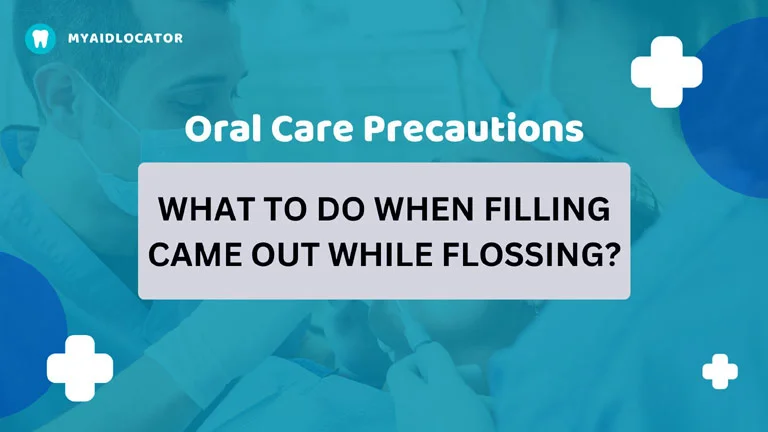If a Filling Came Out while flossing, it’s essential to take immediate action. Flossing too aggressively or using improper flossing techniques can potentially dislodge a filling. It’s important to be gentle when flossing around filled teeth and to avoid snapping the floss down forcefully.
Gently rinse your mouth with warm water to remove any debris or loose filling material. Be cautious not to swallow any of it. Schedule an appointment with your dentist as soon as possible to have the filling replaced or address any underlying issues.
Oral Care Precautions
Oral care precautions are important for maintaining good dental hygiene and preventing dental problems like caries and cavities. Brush your teeth at least twice a day, preferably in the morning and before bedtime. Use a soft-bristle toothbrush and fluoride toothpaste. It will help remove food particles, plaque, and bacteria from mouth.
Floss Daily. Flossing removes food particles and plaque from between your teeth and along the gumline. Consider using an antimicrobial or fluoride mouthwash as part of your oral care routine. It reduces bacteria and strengthen tooth enamel.
Why filling came out while flossing
Over time, dental fillings can deteriorate or wear down, especially if they are old or have been in place for many years. The constant pressure from chewing and the natural wear and tear on the filling material can cause it to weaken and eventually come loose.
If a filling was not properly bonded or sealed during the initial placement, it may not adhere securely to the tooth. This can make it more susceptible to dislodging when subjected to the forces of flossing or chewing.
Temporary Solutions
If needed, you can use over-the-counter dental cement or temporary filling material to cover the exposed area temporarily until you see your dentist. Temporary solutions for dental issues can help alleviate discomfort and protect your oral health until you can see a dentist for a permanent solution.
If a tooth is broken or chipped, rinse your mouth with warm water to clean the area. If there is bleeding, apply gentle pressure with gauze. To protect the tooth, you can cover the sharp edges with dental wax or sugarless gum. Seek dentist immediately for assessment and treatment.
What to Do if filling came out while flossing
If a dental crown or bridge becomes loose or falls off, clean the inside of the restoration and the affected tooth. You can use dental adhesive or temporary cement available at drugstores to temporarily reattach the crown or bridge. Make sure to see your dentist promptly for permanent reattachment.
Over-the-counter pain relievers like ibuprofen or acetaminophen can help manage toothache pain temporarily. Rinse your mouth with warm saltwater to reduce inflammation. Avoid placing aspirin directly on the tooth or gum, as it can lead to tissue damage.
Taking care of oral Health
- Use gentle, circular motions to clean all tooth surfaces.
- Be sure to brush your tongue and the roof of your mouth to remove bacteria.
- Brush for two minutes to ensure thorough cleaning.
- Eat a balanced diet rich in fruits, vegetables, whole grains, lean proteins, and low-fat dairy products.
- Stay Hydrated
- Regular Dental Check-Ups
- Quit Smoking and Tobacco
Wrap up
The first step when you notice a filling has come out while flossing is to stop flossing or engaging in any dental activities in that area. Continuing to floss can worsen the situation, leading to further damage or discomfort.
Remember that addressing a lost filling promptly is essential to prevent further complications, and seeking professional dental care is the best course of action. Avoid trying to fix the filling yourself, as improper handling can lead to more problems.
FAQ’s
Flossing and brushing after a dental filling procedure are important parts of maintaining good oral hygiene. It will ensure that the treated tooth and the surrounding area remain clean, reducing the risk of infection or complications.
Be careful when brushing and flossing around the filled tooth. Do not apply excessive pressure.
Your dentist is the best person to evaluate the situation and recommend the appropriate treatment. Meanwhile, Rinse your mouth with warm water to remove any debris or remaining filling material. It will help you assess the situation more clearly and prevent infection.
In some cases, they may recommend waiting a few hours before resuming normal oral hygiene routines to allow the filling material to set properly. When you do start flossing again, be gentle around the treated tooth, especially if the filling was deep or if you experienced any discomfort during the procedure. Avoid putting too much pressure on the floss near the filled area.
Flossing does not generally cause pain after a dental filling if the filling is properly placed and the surrounding gum tissue is healthy. However, if your dental filling is loose, cracked, or improperly sealed, it can create irregularities on the tooth’s surface. When you floss, the floss may catch on these irregularities, leading to pain or discomfort. In such cases, it’s important to see your dentist promptly to evaluate and potentially repair or replace the filling.
Flossing and brushing your teeth should not typically cause a well-placed dental filling to come out or become damaged. Dental fillings are designed to be stable and durable under normal oral hygiene practices. But Excessive force or aggressive brushing and flossing can potentially lead to damage to the filling or surrounding tooth structure over time.

